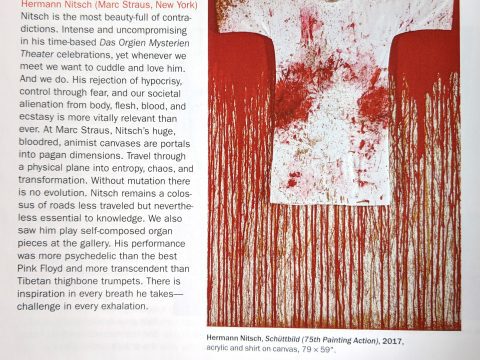Hermann Nitsch’s Imitatio Christi by Donald Kuspit

Hermann Nitsch is an Austrian performance artist, in this exhibition performing with paint—making what he calls Schuttbilder—the 75th one, a seemingly endless group of paintings—but he’s better known for his performances in his Orgien Mysterien Theater, where animal blood and guts, along with naked (and shapely) female bodies were his preferred medium. All of this is rather sensational, and the paintings in the exhibition are sensationally painterly—gesturalism run amuck, the gestures interacting with orgiastic intimacy, if sometimes looking like glorious muck (the footprints of the studio cat appear in one of them, as though left by some miniature dinosaur in prehistoric mud). Many of the paintings are blood red, as though Nitsch thinks of painting as spilling blood—indeed, I want to suggest, the blood of Christ. The allusion to Christ was there from the beginning, for the cross—signaling the crucifixion (Nitsch was in effect crucifying—mortifying–the body, the animal body, draining it of blood to liberate the soul, and with that saving it from a fate worse than death, namely, damnation)—was a staple of most of the performances. Without its triumphant presence the sacrifice of the body on the altar of art would be in vain—or just another pretentious theatrical act, a grandstanding display of artistic hubris.
That cross re-appears in many of the Schuttbilder, in the form of the white garment that Nitsch wore when he painted them. It is now stained with paint, implicitly blood (and a bit of flesh, as some of the colors suggest), and spread on the canvas in the form of a cross, the way Christ’s body was stretched on the cross. More deeply, to paint with passion is to re-live the Passion of Christ and to die on the cross with Him, thus becoming one with Him, and be resurrected in art. For Nitsch making art is as great as sacred, mystery ritual as the ritual worship of Christ—as great a religion as Christianity. Painting is a religious activity for Nitsch, and to be a painter is identify with Christ—to practice the so-called imitatio Christi, as Albrecht Dürer famously did in his 1500 Self-portrait and in a 1522 drawing, where he points to a painful spot on the side of his body, in effect a wound from the spear that pierced Christ’s body as he was hanging on the cross, sacrificing himself for humankind. Like Christ on the cross, Dürer is naked except for a loincloth. Dürer in his representational way, and Nitsch in his abstract way, practiced The Imitation of Christ (De Imitatione Christi), an influential devotional book written by Thomas a Kempis ca. 1418. The point is made decisively by Nitsch’s Entombment, 2007 a work in which Christ stands upright, as though ready to be resurrected, the way Nitsch does when he resurrects himself by painting, as the video of him doing so suggests. Nitsch may be the last of the medieval religious—Catholic—painters, disguised as a modernist painter, that is, a nihilistic expressionist, the viscerality of his paintings belying and denying their abstractness.
“The real problem of modernity is the problem of belief,” the sociologist Daniel Bell wrote. “It is a spiritual crisis, since the new anchorages have proved illusory and the old ones have been submerged. It is a situation which brings us back to nihilism.” Art becomes the way out of nihilism, “the romantic gateway to the realm of spirit for all those over whom the old religions have lost their hold,” the historian Jacques Barzun wrote. Nitsch’s painting shows that the old religion of romantic art and the old religion of Christianity still have spiritual credibility, however theatrical both have become.
(Note: The gallery calls each “Schuttbilder” a “painting action,” that is, an action painting, but the German “Schutt” means “rubbish, scree, rubble,” “scree” probably the best word for them, because a scree is a “steep mass of loose rock on the slope of a mountain.” The paint in Nitsch’s works falls like an avalanche, and several of the paintings evoke mountain scenery—in general they have a steep verticality—probably in the area of the countryside, about an hour from Vienna where Nitsch paints.)
This article originally appeared on: https://whitehotmagazine.com/articles/hermann- nitsch-s-imitatio-christi/3778
About the Author, Donald Kuspit
Donald Kuspit is one of America’s most distinguished art critics. In 1983 he received the prestigious Frank Jewett Mather Award for Distinction in Art Criticism, given by the College Art Association. In 1993 he received an honorary doctorate in fine arts from Davidson College, in 1996 from the San Francisco Art Institute, and in 2007 from the New York Academy of Art. In 1997 the National Association of the Schools of Art and Design presented him with a Citation for Distinguished Service to the Visual Arts. In 1998 he received an honorary doctorate of humane letters from the University of Illinois at Urbana-Champaign. In 2000 he delivered the Getty Lectures at the University of Southern California. In 2005 he was the Robertson Fellow at the University of Glasgow. In 2008 he received the Tenth Annual Award for Excellence in the Arts from the Newington-Cropsey Foundation. In 2013 he received the First Annual Award for Excellence in Art Criticism from the Gabarron Foundation. He has received fellowships from the Ford Foundation, Fulbright Commission, National Endowment for the Arts, National Endowment for the Humanities, Guggenheim Foundation, and Asian Cultural Council, among other organizations.



